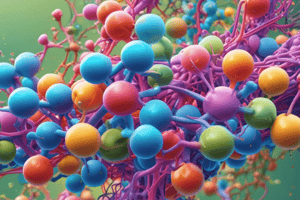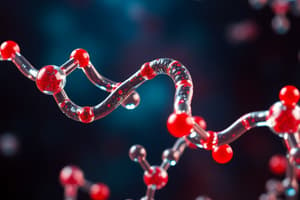Podcast
Questions and Answers
What is the term for structurally similar compounds that have the same functional groups?
What is the term for structurally similar compounds that have the same functional groups?
- Group similarity
- Functional equivalence
- Group specificity (correct)
- Functional uniformity
What does linkage specificity refer to in enzyme activity?
What does linkage specificity refer to in enzyme activity?
- Breaking down all types of bonds
- Recognition of specific bonds for catalysis (correct)
- Bonding with any nearby molecule
- Cleavage of amino acids from any end of the peptide chain
Why does higher temperature lead to increased enzyme activity?
Why does higher temperature lead to increased enzyme activity?
- Higher kinetic energy and more reactant collisions (correct)
- Decreased substrate concentration
- Increased denaturation rate
- Enhanced protein stability
What is the optimum temperature for human enzymes according to the text?
What is the optimum temperature for human enzymes according to the text?
How do drastic changes in pH affect enzyme activity?
How do drastic changes in pH affect enzyme activity?
At a constant enzyme concentration, what happens to enzyme activity with increased substrate concentration?
At a constant enzyme concentration, what happens to enzyme activity with increased substrate concentration?
What is the enzyme specificity where an enzyme can catalyze a particular reaction for only one substrate?
What is the enzyme specificity where an enzyme can catalyze a particular reaction for only one substrate?
In which model for substance binding to enzymes does the enzyme have a predetermined shape for the active site?
In which model for substance binding to enzymes does the enzyme have a predetermined shape for the active site?
Which type of interactions play a role in determining substrate binding to enzymes?
Which type of interactions play a role in determining substrate binding to enzymes?
What is the intermediate reaction species formed when the substrate binds with the active site of an enzyme?
What is the intermediate reaction species formed when the substrate binds with the active site of an enzyme?
Which factor can affect enzyme activity by allowing a small change in space to accommodate a substrate?
Which factor can affect enzyme activity by allowing a small change in space to accommodate a substrate?
Which enzyme has stereochemical specificity in distinguishing between L-amino acids and D-amino acids?
Which enzyme has stereochemical specificity in distinguishing between L-amino acids and D-amino acids?
What type of reaction does an oxidoreductase enzyme catalyze?
What type of reaction does an oxidoreductase enzyme catalyze?
Which suffix is commonly found in the names of some digestive enzymes?
Which suffix is commonly found in the names of some digestive enzymes?
What is the role of a hydrolase enzyme?
What is the role of a hydrolase enzyme?
Which coenzyme is required for an oxidoreductase enzyme?
Which coenzyme is required for an oxidoreductase enzyme?
What is the primary function of enzymes with the suffix -ase?
What is the primary function of enzymes with the suffix -ase?
How are oxidation and reduction reactions related in the context of oxidoreductase enzymes?
How are oxidation and reduction reactions related in the context of oxidoreductase enzymes?
What is the major function of B Vitamins?
What is the major function of B Vitamins?
Which vitamin is synthesized by bacteria in the colon?
Which vitamin is synthesized by bacteria in the colon?
What is the role of vitamin A in vision?
What is the role of vitamin A in vision?
Which vitamin has a hydrocarbon-like structure with fewer functional groups?
Which vitamin has a hydrocarbon-like structure with fewer functional groups?
What is the source of approximately half of the dietary need for Vitamin K?
What is the source of approximately half of the dietary need for Vitamin K?
Which Vitamin is also known as pyridoxine, pyridoxal, and pyridoxamine?
Which Vitamin is also known as pyridoxine, pyridoxal, and pyridoxamine?
What is the process in which enzyme activity is altered by covalently modifying the enzyme structure?
What is the process in which enzyme activity is altered by covalently modifying the enzyme structure?
Which family of antibiotics inhibits specific enzymes essential to life processes of bacteria?
Which family of antibiotics inhibits specific enzymes essential to life processes of bacteria?
What is the most common covalent modification involving the addition and removal of a group from an enzyme?
What is the most common covalent modification involving the addition and removal of a group from an enzyme?
Which type of enzymes catalyze the removal of phosphate group in covalent modification?
Which type of enzymes catalyze the removal of phosphate group in covalent modification?
What happens if premature production of pepsin occurs in the stomach?
What happens if premature production of pepsin occurs in the stomach?
Zymogens are also known as:
Zymogens are also known as:
Flashcards
Analogs
Analogs
Structurally similar compounds sharing the same functional groups.
Linkage specificity
Linkage specificity
Refers to an enzyme's ability to catalyze a reaction at a specific bond or linkage in a substrate molecule.
Temperature and Enzyme Activity
Temperature and Enzyme Activity
Enzyme activity increases with temperature until the enzyme denatures.
pH and Enzyme Activity
pH and Enzyme Activity
Signup and view all the flashcards
Substrate Concentration and Enzyme Activity
Substrate Concentration and Enzyme Activity
Signup and view all the flashcards
Absolute specificity
Absolute specificity
Signup and view all the flashcards
Lock-and-key model
Lock-and-key model
Signup and view all the flashcards
Induced fit model
Induced fit model
Signup and view all the flashcards
Forces Involved in Substrate Binding
Forces Involved in Substrate Binding
Signup and view all the flashcards
Enzyme-Substrate Complex (ES complex)
Enzyme-Substrate Complex (ES complex)
Signup and view all the flashcards
Inductive fit
Inductive fit
Signup and view all the flashcards
Stereochemical specificity
Stereochemical specificity
Signup and view all the flashcards
Oxidoreductases
Oxidoreductases
Signup and view all the flashcards
Hydrolases
Hydrolases
Signup and view all the flashcards
Function of "-ase" Suffix
Function of "-ase" Suffix
Signup and view all the flashcards
Oxidation and Reduction in Oxidoreductases
Oxidation and Reduction in Oxidoreductases
Signup and view all the flashcards
B Vitamins
B Vitamins
Signup and view all the flashcards
Vitamin A
Vitamin A
Signup and view all the flashcards
Covalent Modification
Covalent Modification
Signup and view all the flashcards
Penicillin
Penicillin
Signup and view all the flashcards
Phosphorylation
Phosphorylation
Signup and view all the flashcards
Phosphatases
Phosphatases
Signup and view all the flashcards
Zymogens
Zymogens
Signup and view all the flashcards
Study Notes
Structural Similarity
- Analogs are structurally similar compounds that have the same functional groups
Specificity of Enzymes
- Linkage specificity refers to the enzyme's ability to catalyze a reaction at a specific bond or linkage in a substrate molecule.
Temperature and Enzyme Activity
- Higher temperatures increase enzyme activity by increasing molecular motion and collisions between enzymes and substrates, leading to faster reaction rates.
- The optimum temperature for human enzymes is 37 °C (98.6 °F)
pH and Enzyme Activity
- Drastic changes in pH can affect enzyme activity by altering their three-dimensional structure (conformation), damaging their active sites, and reducing their efficiency.
Substrate Concentration and Enzyme Activity
- At a constant enzyme concentration, increasing substrate concentration increases enzyme activity until a saturation point is reached, where all active sites are occupied by substrate.
Types of Enzyme Specificity
- Absolute specificity refers to when an enzyme can catalyze a particular reaction for only one substrate.
Models for Enzyme-Substrate Binding
- The lock-and-key model proposes that an enzyme has a predetermined shape for the active site that perfectly complements the substrate.
- Induced fit model states that the active site is flexible and adjusts its shape in response to substrate binding.
Forces Involved in Substrate Binding
- Noncovalent interactions, including hydrogen bonds, ionic interactions, van der Waals forces, and hydrophobic interactions, play a role in determining substrate binding to enzymes.
Enzyme-Substrate Intermediate
- The formation of an enzyme-substrate complex (ES complex) represents an intermediate reaction species formed when a substrate binds with the enzyme's active site.
Inductive Fit and Active Site Flexibility
- Inductive fit allows a slight change in the active site's shape to accommodate a substrate.
Stereochemical Specificity
- Stereochemical specificity occurs in enzymes that can distinguish between L-amino acids and D-amino acids, for example, L-amino acid oxidase catalyzes the oxidation of L-amino acids but not D-amino acids.
Oxidoreductase Enzymes
- Oxidoreductases catalyze oxidation-reduction reactions, which involve the transfer of electrons between molecules, with one molecule being oxidized and the other reduced.
Naming Digestive Enzymes
- The suffix "-ase" is commonly found in the names of some digestive enzymes, e.g., peptidase, lipase, and amylase.
Hydrolase Enzyme Function
- Hydrolases catalyze the hydrolysis reaction, cleaving chemical bonds by adding a water molecule.
Coenzymes in Oxidoreductases
- Nicotinamide adenine dinucleotide (NAD+) is a common coenzyme required for oxidoreductase enzymes.
Function of "-ase" Suffix
- Enzymes with the suffix "-ase" primarily function as biological catalysts, speeding up chemical reactions in living organisms without changing the equilibrium of the reaction.
Oxidation and Reduction in Oxidoreductases
- Oxidation and reduction reactions are coupled processes in oxidoreductases, where one molecule loses electrons (oxidation) while another gains electrons (reduction).
Vitamins: Structure and Function
- B Vitamins function as coenzymes in various metabolic reactions.
- Vitamin K is synthesized by bacteria in the colon and is also obtained from dietary sources (approximately 50%).
- Vitamin A plays a crucial role in vision by converting retinal to rhodopsin, a light-sensitive pigment.
- Vitamin E has a hydrocarbon-like structure with fewer functional groups and acts as an antioxidant.
Covalent Modification of Enzymes
- Covalent modification is a process in which enzyme activity is altered by covalently modifying the enzyme's structure.
Antibiotics and Enzyme Inhibition
- Penicillin belongs to a family of antibiotics that inhibit specific enzymes essential to the life processes of bacteria.
Phosphorylation
- Phosphorylation, the addition and removal of a phosphate group, is the most common covalent modification of enzymes.
- Phosphatases are enzymes that catalyze the removal of a phosphate group in covalent modification.
Premature Pepsin Production
- Premature production of pepsin in the stomach can lead to gastric ulcers, as it starts to digest the stomach lining.
Zymogens
- Zymogens are inactive precursors of enzymes, also known as proenzymes.
Studying That Suits You
Use AI to generate personalized quizzes and flashcards to suit your learning preferences.



